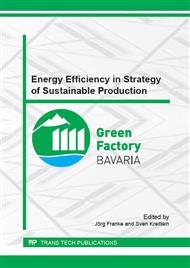p.3
p.11
p.19
p.25
p.32
p.38
p.46
p.53
The Least Energy Demand Method as Metric to Evaluate Different Production Levels Based on the Relative Energy Efficiency
Abstract:
This paper presents a calculation system for evaluating the energy efficiency at machine, plant, location, company, and sector level based on the process specific minimum energy demand. The goal is a comparability of the energy efficiency across machines, plants, locations, companies, and sectors through definition of significant key figures. The basis of the derivation of possible saving potentials is the relative energy efficiency (REE). [7] It is determined by the quotient of minimal energy demand and actually measured consumption and requires that the actually measured energy consumption refers to an independent basis of comparison. The step-by-step development of the calculation system, structured in levels, is based on the detailed analysis of all the influential factors of the energy consumption with the help of cause and effect diagrams to calculate the minimally necessary energy demands for the manufacturing process. Furthermore, the described bottom-up approach delivers, ensuing from the process oriented level of perspective, the step-by-step conception of the calculation method. The REE of a level of perspective is calculated on the basis of the REE value of the previous production level as well as according weighting factors. On the basis of the calculation, as well as subsequent measurements within the company, optimization potentials [10] can be clearly described and can lead back to their roots. These optimization potentials are based on exemplary trials presented for a chosen manufacturing chain of the electronics production area.
Info:
Periodical:
Pages:
3-10
Citation:
Online since:
November 2015
Authors:
Price:
Сopyright:
© 2015 Trans Tech Publications Ltd. All Rights Reserved
Share:
Citation:


